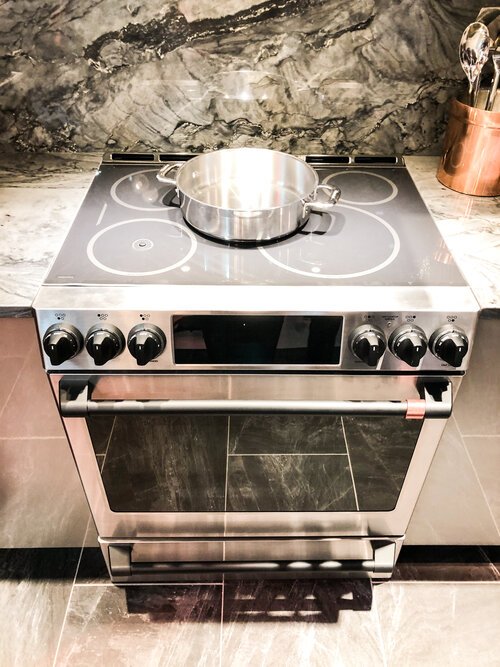What You Should Know About Induction Cooktops
Kitchen display from KBIS 2019
Want some kitchen inspiration for your cooking space? I’ve got you covered.
As different cities begin banning the installation of new gas appliances or gas lines, it may leave you wondering, ‘well, now what do I do?’ - in California (and I’m sure other high-fire areas), we’re facing code modifications that will impact our appliance selections in the future, as the installation of natural gas lines may not be an option. If you are looking for an option that cooks as evenly and as quickly as gas, you may be interested in learning more about induction cooktops! They have some great safety features, are easy to clean (hello nice flat surface!), and have a simple, low-profile look to them (as you can see in the image above). Let’s dive into all the benefits, shall we?
One of the most popular questions about induction cooktops is how they actually work… they’re electric and conduct heat between their surface and the bottom surface of a pot or pan. It’s true that not all pots and pans work with induction; the bottom of the pots and pans need to have a magnetic based material like cast iron or stainless steel. Since the heat is transferred directly to from the cooktop to the pot/pan, it’s a more efficient way to cook than gas or the older electric cooktops. A model like the Thermador cooktop in the first image above doesn’t have ‘burners’ - the entire cooktop can be used for cooking, which means any size pot, pan or griddle you have (with magnetic bottom of course), will work and you don’t have to worry about burner size or where you place the pot or pan on the cooking surface. Don’t worry - the entire surface doesn’t heat up, only the area with the pot/pan on it. The number one safety feature of induction cooktops is exactly this - they don’t heat up if there isn’t a pot or pan on it. So, imagine you turn it on to start dinner, and the phone rings… you get distracted, walk away and forget all about it - that’s OK! Nothing will happen, unlike a gas cooktop, which will leave you with an unsupervised open flame!
There are a variety of manufacturers and styles to pick from - don’t like the touch screen or digital controls? You can go with an induction range that has the knobs on the front, as shown in the second photo. Other models have ‘burners’ or designated cooking areas on the cooktop that indicate their maximum power output or cooking features (like simmer), based on their size on the cooktop. With most of these models, your pot or pan will need to be completely on the ‘burner’ surface in order for the induction cooking to work.
So, in addition to the superior safety features, even cooking/heating, and simplicity to clean, there’s one more benefit… you can use a downdraft hood without having to worry that the pull from the hood will rob your gas flame of it’s maximum output! If you don’t have an overhead hood that would pull the heat/steam from your cooktop and exhaust it through an exterior wall or roof, then you likely have what we call a downdraft hood, which is mounted into the countertop and draws the cooktop exhaust down through ductwork under your floor and vents out through the crawl space. This can be common in islands, if you don’t want an overhead hood. If you’re using a downdraft hood with a gas flame, you’re instantly reducing the power of your gas flame and cooking, but not with induction! The hood will draw only the steam and exhaust it through the crawl space.
Induction cooktop with downdraft hood on sides
So, now that you know a little more about induction cooktops, is this something you’d put in your kitchen? Tell me in the comments below or let me know what questions you have!
Want to create your dream kitchen to cook in? Let’s talk about your ideal space today.


